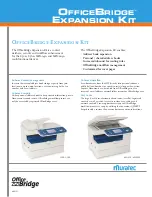
29
2.4 Encryption and Signature Function
Note
Even if you specify [No], user ID and password may be required at the time of access.
If [Remote] is set to
> [Device] > [Authentication/Accounting] > [Authentication/Security Settings] >
[Authentication] > [Authentication/Accounting Settings], the machine accesses to external services
using user information authenticated with the machine after selecting [No].
You can specify whether or not to display authentication screen when accessing an external service in
> [Device] > [App Settings] > [Web Applications Setup] > [Other Settings] > [When Sending User
Details].
[User ID]
Specify the user ID for authentication in external services.
Note
Depending on the external service, the setting may be invalid even if you specify [User ID]. Check the
setting for the used external service.
[Password]
Specify the password for authentication.
[Notify Device/Authentication Info]
You can specify whether or not to notify the information to identify this machine and the certificate
information of the user to the connection destination every time you connect to an external service.
Note
Whether or not such information will be used is determined by the connecting external service, so you
normally would not perform the setting on the operation panel.
[Notify Permission Information]
You can specify whether or not to notify the authorization information of the user to the connection
destination every time you connect to an external service.
[Functional Code]
You can specify this as necessary when using the linked service with another device.
Server Certificate Verification
Configure the settings to verify the server certificate when connecting with an external server (ASP)
in the same manner as the Windows web browser to prevent phishing attacks.
To verify a server certificate, the route certificate (CA certificate) for the route certificate agency
issuing the server certificate is used.
Note
CA certificate files are compatible with the following formats.
- DER encoded binary X.509 format (.CER)
- Base64 encoded X.509 format (.CER)
- Cryptographic Message Syntax Standard - PKCS #7 certificate format (.P7B)
2.4
Encryption and Signature Function
Certificate
A certificate is required to use the encryption and signature functions.
To create/delete, import/export, or enable a certificate, use Internet Services.
Refer
For details, refer to Internet Services help.
Содержание Apeos C3070
Страница 51: ...SIQA_sheet_A3_simplex ...
Страница 52: ...SIQA_sheet_A3_simplex ...
Страница 53: ...SIQA_sheet_A3_duplex ...
Страница 54: ...SIQA_sheet_A3_duplex ...
Страница 55: ...SIQA_sheet_11x17_simplex ...
Страница 56: ...SIQA_sheet_11x17_simplex ...
Страница 57: ...SIQA_sheet_11x17_duplex ...
Страница 58: ...SIQA_sheet_11x17_duplex ...
















































